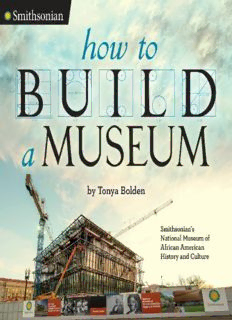
How to Build a Museum: Smithsonian’s National Museum of African American History and Culture PDF
Preview How to Build a Museum: Smithsonian’s National Museum of African American History and Culture
History, as nearly no one seems to know, is not merely something to be read. And it does not refer merely, or even principally, to the past. On the contrary, the great force of history comes from the fact that we carry it within us, are unconsciously controlled by it in many ways, and history is literally present in all that we do. It could scarcely be otherwise, since it is to history that we owe our frames of reference, our identities, and our aspirations. —James Baldwin, “The White Man’s Guilt,” 1965 Walk with the sun, Dance at high noon; And dream when night falls black; But when the stars Vie with the moon, Then call the lost dream back. —Lewis Alexander, “Dream Song,” 1926 CONTENTS Title Page Epigraphs Preface Dream Have a Vision Go Treasure Hunting Build a Fitting Home Welcome the World Facts and Figures Acknowledgments Credits Copyright Notes Index A digital image from the architect’s plans for Smithsonian’s National Museum of African American History and Culture (NMAAHC) in Washington, DC. PREFACE A museum is a treasure trove of things. Things lost then found. Things perennially prized. Objects once deemed worthless. Whatever a museum collects—paintings, pottery, or playthings—its aim is the same: to safeguard remnants of history and culture that inspire, enlighten, and kindle the curiosity of the children and adults who come through its doors, generation after generation. Smithsonian’s National Museum of African American History and Culture is a treasure trove of paintings, photographs, posters, playbills, pottery, documents, dolls, diaries, books, balls, bells, benches, medals, medallions, and more: objects that deepen our understanding of the black experience in America and so strengthen our grasp of American history. This is the story of how that magnificent and monumental museum got built. A view of the National Mall from the Smithsonian Castle, circa 1915. DREAM “The meeting of the Colored Citizens’ Committee for the entertainment of Old Veterans and Delegates to the G.A.R. Encampment . . . was very well attended last Saturday evening.” —The Washington Bee, June 19, 1915 Smithsonian’s National Museum of African American History and Culture was a long time coming. It was a hundred-year hope, a hundred-year dream rooted in the desire for a tribute in the United States’ capital to black patriots. The dream began to take shape in September 1915 during a big reunion: the Grand Army of the Republic’s Forty-ninth National Encampment. The GAR was an organization of veterans who had served in the Union’s armed forces during the Civil War (1861–1865). Fifty years after the war ended, thousands of former servicemen from more than forty states poured into the nation’s capital. They came with war wounds and disabilities, with medals and memorabilia. They came with memories of battles lost and won, of fallen comrades, of heroism unsung. Their average age was seventy-three. Despite old age and infirmities, more than twenty thousand veterans proudly marched in the big parade up Pennsylvania Avenue. A contingent of those GAR members were African American, representing the roughly 200,000 black boys and men who had fought for the Union on land and sea. During the encampment, black Washingtonians saw to it that these Civil War survivors were properly housed, fed, and feted. Civic leader and government worker Ferdinand D. Lee headed up the committee in charge of this hospitality. September 29, 1915: The Grand Army of the Republic’s parade up Pennsylvania Avenue, America’s Main Street. Before the GAR Encampment ended on October 2, Ferdinand D. Lee and company made up their minds to take their pride in sable soldiers and sailors a step further. They rallied around an idea already in the air, and within months of the GAR reunion, Ferdinand D. Lee was at the helm of a new organization: the National Memorial Association for the Erection of a Monument at the National Capital in Honor of the Negro Soldiers and Sailors Who Fought in the Wars of Our Country. The group became known for short as the National Memorial Association (NMA). A photograph (circa 1864–1865) and the military I.D. tag of Sergeant Qualls Tibbs (1836–1922), a Virginia-born member of the United States Colored Troops, 27th Regiment, Company E.
Description: